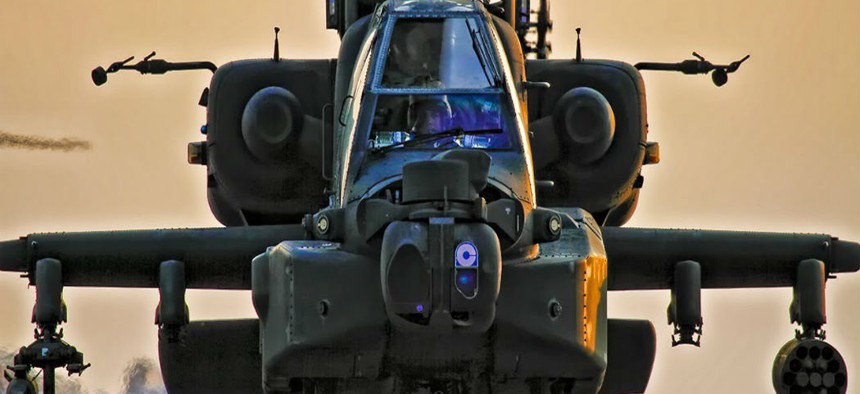Army expands manned-unmanned helicopter teaming
Army officials say the combination of the Apache’s lethal weapons and the drones’ sensors enable helicopter crews to find and go after dynamic or fast-moving targets from further ranges.
Army weapons developers are accelerating emerging technology for the Apache attack helicopter which enables crews to view real-time video feeds from nearby drones, control the drones’ flight path and therefore more effectively destroy enemy targets, service officials said.
Manned-Unmanned Teaming, or MUM-T, gives AH-64E Apaches an ability to control the flight path and sensor payload of Army Shadow and Gray Eagle drones.
As part of the continuation of the Army’s development of this technology, Boeing was awarded a $24 million contract for manned and unmanned teaming expanded compatibility on all Apache attack helicopter AH-64E configurations.
Army officials say the combination of the Apache’s lethal weapons and the drones’ sensors enable helicopter crews to find and go after dynamic or fast-moving targets from further distance.
Manned-Unmanned Teaming was recently used with great success in Afghanistan by the 1-229th Attack Reconnaissance Battalion, Army officials said. In addition, Apache helicopters are providing air support to Iraqi Security Forces advancing on Mosul.
Looking at real-time Electro-Optical/Infra-red images from drone cameras in the Apache cockpit gives crews an increased ability to target more effectively groups of enemy fighters on the move.
“Now before the unit even deploys out of the Forward Arming Refueling Point, or FARP, they can actually bring up the UAS (drone) feed, look through the sensors and see the target they are going to attack up to 50 or 60 miles away,” Apache Program Manager Col. Jeff Hager said. .
Hager also explained that maintaining drone sensors on targets which can move and change gives the Apache crew an opportunity to make adjustments while en-route to a target location.
“They have full situational awareness on that target as they fly inbound and do not lose any data on that target on the way,” Hager added. “They don’t go into a situation where they are surprised.”
Apache pilots in Afghanistan are now flying upgraded AH-64E-model helicopters which give the platform increased speed and performance. In development for many years and now part of the operational force, the AH-64E models use a stronger 701D helicopter engine, composite rotor blades and next-generation communications technology and avionics.
“The additional power and capability that the aircraft brings actually changes the face of the battlefield. Now they can close, maintain and assume contact activities with the enemy at a much faster rate. The enemy could [estimate] the amount of time it was going to take the Delta (“D” model Apache) models to get to them. We completely threw that out the window and they (the “E” model Apache crews) can get there much faster,” Hager explained.
The ‘E” model is able to transport a larger amount of ammunitions and fuel in what is described as “high-hot” conditions at altitudes of 6,000 feet and temperatures of 95-degrees or above. The innovations built into the “E” model give the helicopter all of the technological advantages of its predecessor “D” model – yet at a lighter weight making it more maneuverable and effective.
The AH-64E Apache is also 20 knots faster than the previous model and can reach speeds of 164 knots.
The current “D” model Longbow Apache is heavier than the original “A” model helicopter; it carries the Longbow radar and significantly improved targeting and sensing technologies, however it lacks the transmission-to-power ratio and hard-landing ability of the initial “A” model. The AH-64E is engineered such that an advanced, high-tech aircraft the weight of the previous “D” model can have the power, performance and landing abilities of an original “A” model with a much lighter weight.
“One of the biggest values of the aircraft (“E” model) itself is the increased performance that we put back into the airframes, specifically from the composite rotor blades. We increased the power of the engines and improved the transmission. That gives the aircraft and Alpha (“A”-model”)-like performance that we have not seen in years,” Hager explained. “The aircraft is faster and more lethal.”
In total, the Army plans to acquire 690 AH-64Es by 2025. “We are getting super feedback from what they were doing over in combat. MUM-T has really changed the state of the battlefield,” Hager added.
NEXT STORY: Air Force advances laser weapon simulation




